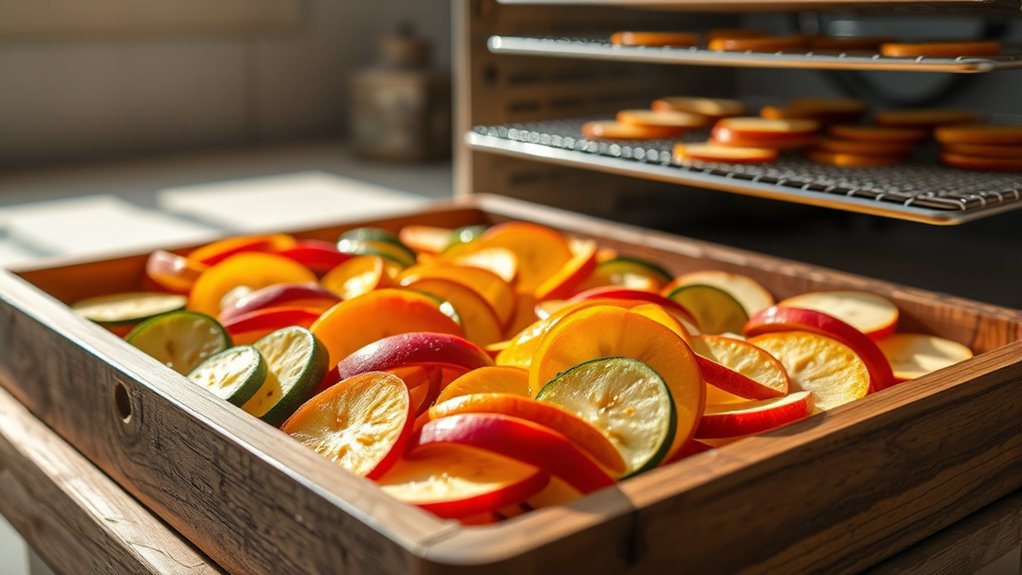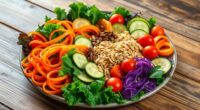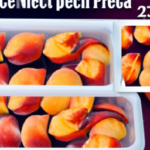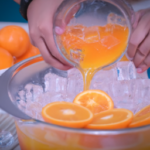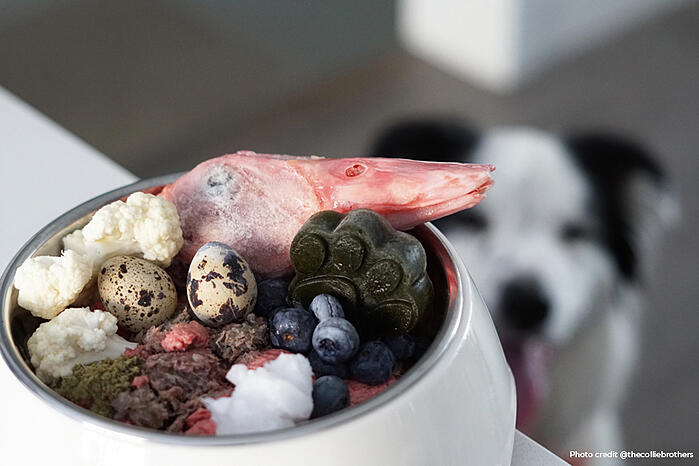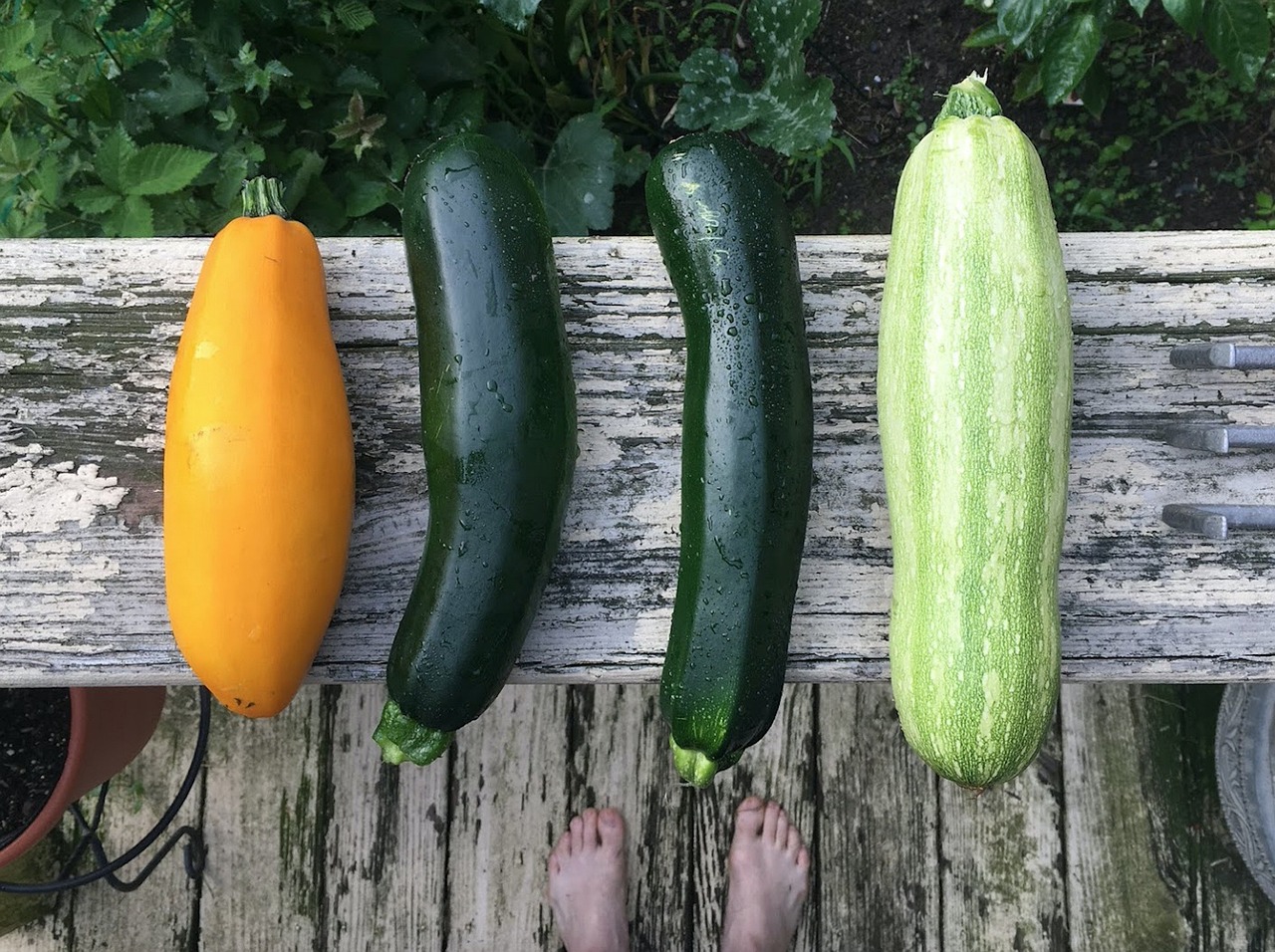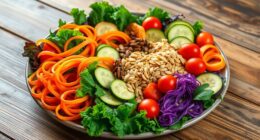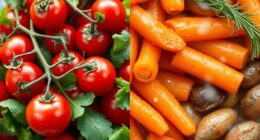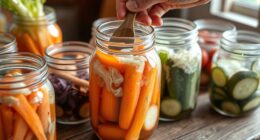To dehydrate raw snacks effectively, choose an energy-efficient dehydrator with adjustable temperature controls and good airflow. Prepare your produce by cleaning, slicing evenly, and removing skins or seeds as needed. Set the dehydrator between 125°F to 135°F and monitor the process to prevent over-drying. Arrange slices in a single layer, rotate trays if necessary, and ensure proper airflow. Proper storage in airtight containers will keep your snacks fresh and tasty—discover more tips to perfect your dehydration process.
Key Takeaways
- Select fresh, ripe produce, wash thoroughly, and slice evenly for uniform dehydration.
- Use an energy-efficient dehydrator with adjustable temperature controls for optimal results.
- Maintain temperatures between 125°F to 135°F and adjust drying time based on produce and thickness.
- Ensure good airflow by arranging snacks in a single layer and rotating trays if necessary.
- Store dehydrated snacks in airtight, dark containers to preserve freshness and crunchiness.
Choosing the Right Dehydration Equipment
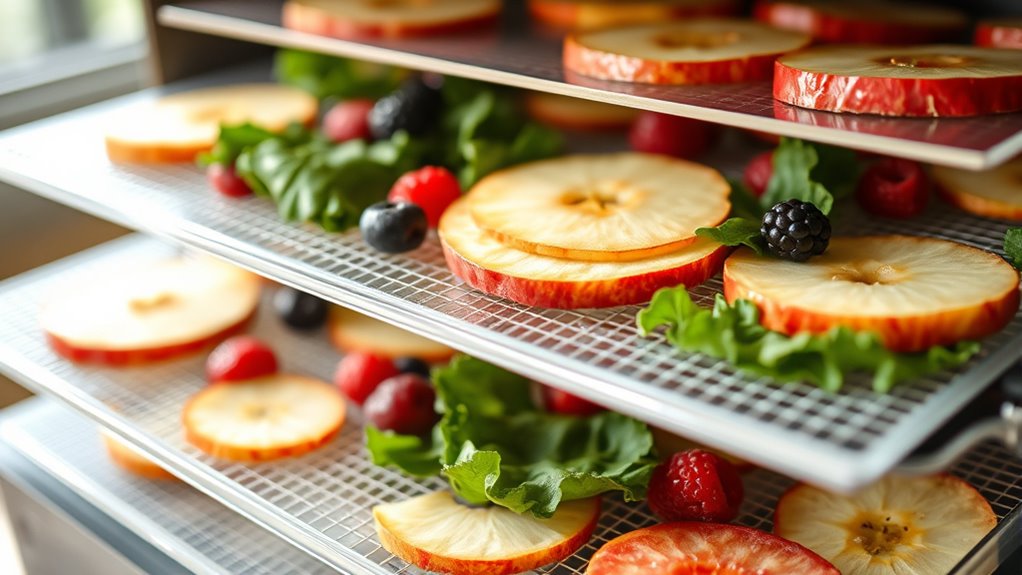
Choosing the right dehydration equipment is vital to guarantee your raw snacks turn out perfect. When comparing options, consider the cost comparison—some models have higher upfront prices but save money in the long run through better energy efficiency. Energy-efficient dehydrators use less power, which keeps your electricity bills low and minimizes environmental impact. Look for models with adjustable temperature controls and good airflow to ensure even drying. Cheaper units might seem appealing initially, but they often consume more energy and produce inconsistent results. Investing in a reliable, energy-efficient dehydrator saves you money over time and delivers better quality snacks. Additionally, selecting a dehydrator with dedicated airflow systems can significantly improve drying uniformity and efficiency. Proper temperature regulation is crucial to preserve the nutrients and flavors of your raw snacks. Utilizing dehydrators with consistent heat distribution can further enhance the quality and consistency of your snacks. Remember, the right equipment balances affordability with performance, and choosing models with advanced temperature controls can provide more precise and consistent drying results, making your dehydration process more efficient and enjoyable.
Preparing Fruits and Vegetables for Dehydration
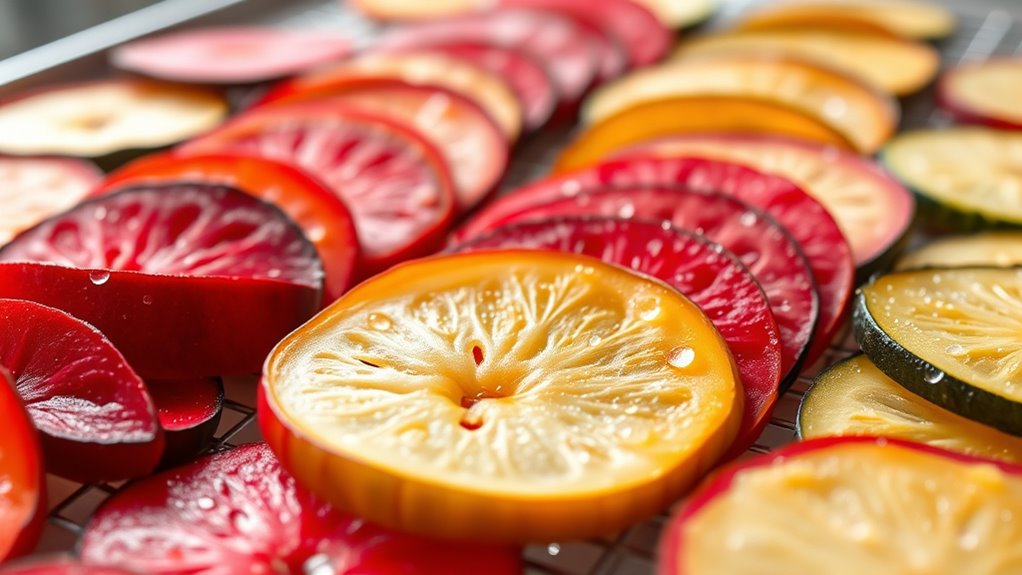
Preparing Fruits and Vegetables for Dehydration
Before dehydrating fruits and vegetables, proper preparation is vital to guarantee even drying and ideal flavor. Start with fruit selection; choose fresh, ripe, and blemish-free produce for the best results. Wash your fruits and vegetables thoroughly to remove dirt and pesticides. Next, slice them evenly to ensure uniform moisture removal. Thinner slices dry faster and more evenly, reducing the risk of uneven texture. Remove skins or seeds if necessary, depending on the type of produce. Pat the slices dry with a towel to eliminate excess surface moisture, which helps prevent mold. Proper preparation minimizes drying time and enhances flavor concentration. Using the right kitchen tools can also facilitate more consistent slicing and preparation. Additionally, maintaining proper airflow during dehydration helps achieve consistent results and prevents moisture buildup. Incorporating dehydration techniques ensures optimal moisture removal and preserves nutrients effectively. Monitoring temperature and humidity levels during dehydration can further improve quality and shelf life. By carefully selecting, washing, slicing, and drying your produce, you set the foundation for successful dehydration and delicious, nutrient-rich snacks.
Optimal Temperature and Time Settings
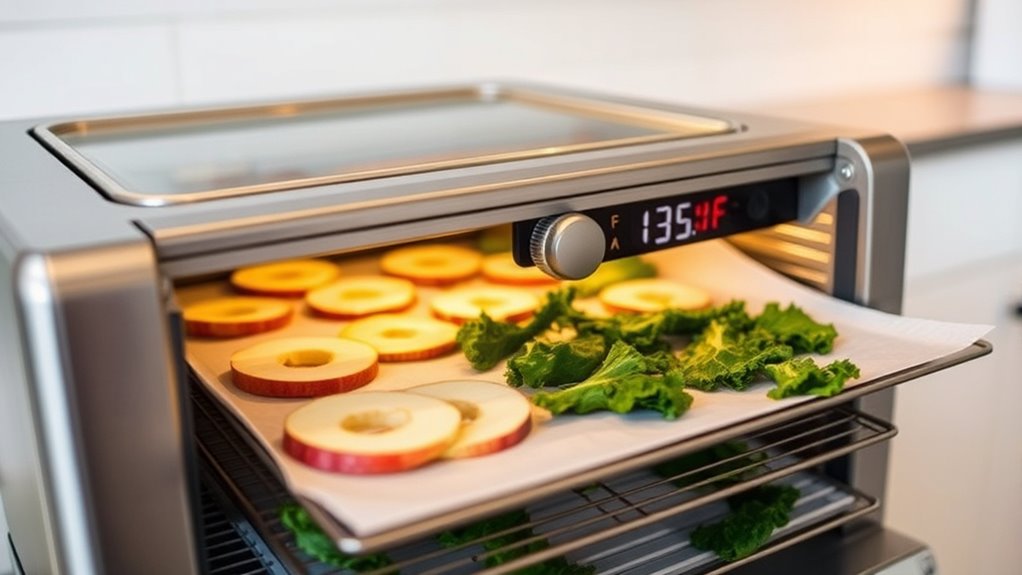
To achieve perfectly dehydrated fruits and vegetables, setting the right temperature and time is essential. Proper temperature control ensures that your snacks dry evenly without losing nutrients or becoming overly crispy. Typically, dehydration occurs between 125°F to 135°F (52°C to 57°C), depending on the produce. Adjusting the drying duration is equally important; shorter times preserve more moisture, while longer times result in a crunchier texture. Keep an eye on your snacks as they dehydrate, and use a timer to prevent over-drying. Factors like humidity and thickness of slices can influence your settings, so it’s best to monitor and tweak as needed. Ultimately, mastering temperature control and drying duration will help you produce delicious, nutrient-rich raw snacks.
Techniques for Even Drying and Texture Control
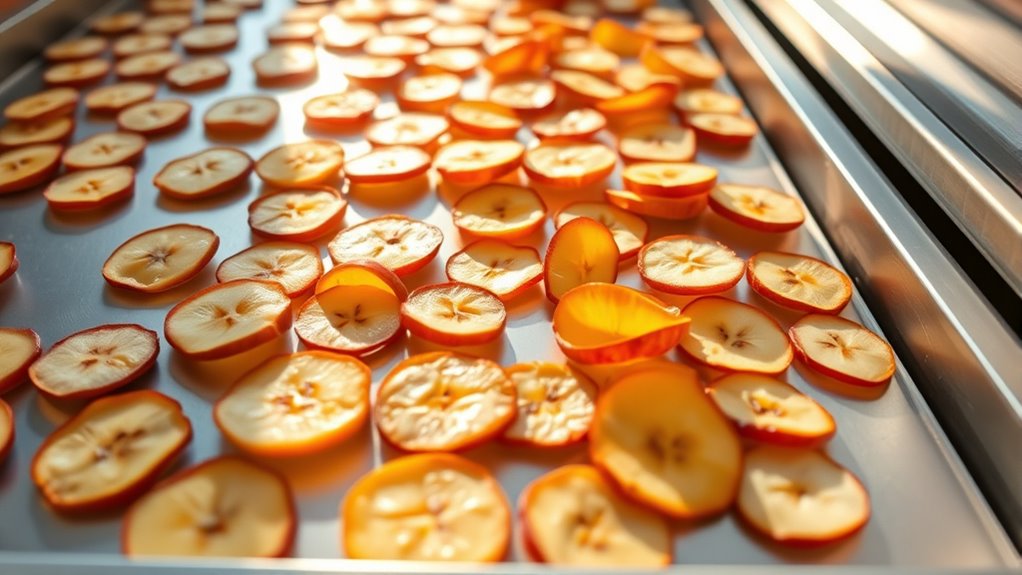
Ensuring even drying and consistent texture in your raw snacks requires attention to detail and proper technique. Good air circulation is key to promoting uniform moisture removal and preventing uneven spots. To achieve this, regularly check your dehydrator’s fan and vents, making sure they are unobstructed. Rotate trays if your dehydrator doesn’t have a fan that circulates air evenly. Keep your snacks in a single layer to maximize exposure to airflow. Proper airflow management can also serve as a good analogy for understanding the importance of consistent airflow in dehydration. Additionally, monitoring humidity levels within your dehydrator can help prevent over-drying and preserve optimal texture. Controlling moisture removal ensures a crisp, even texture without over-drying. Proper airless paint sprayer management can also serve as a good analogy for understanding the importance of consistent airflow in dehydration. Incorporating mindfulness practices such as focused observation during the drying process can help you better gauge when your snacks are perfectly dehydrated.
Storing and Preserving Dehydrated Snacks
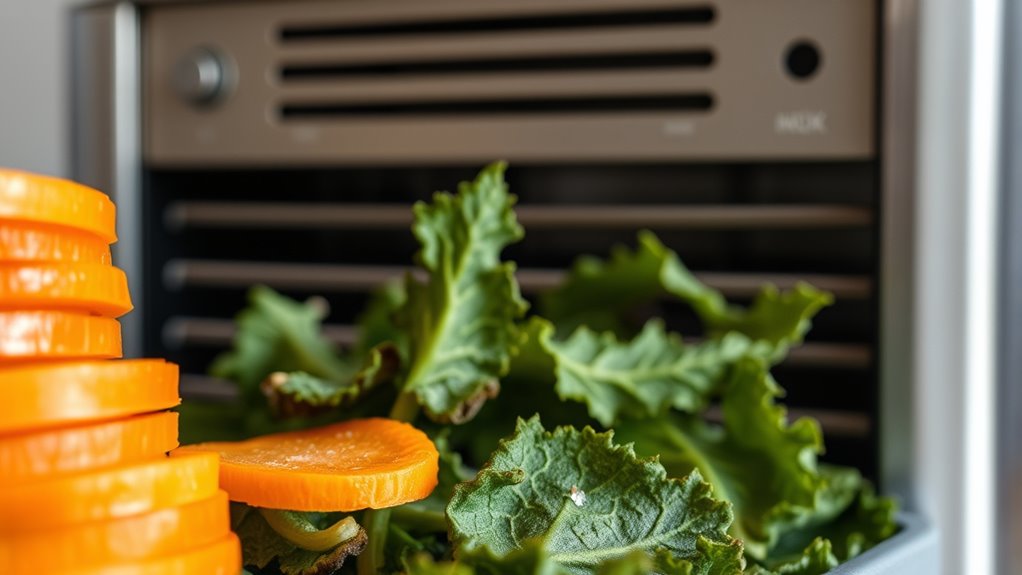
Have you considered the best ways to store your dehydrated snacks to keep them fresh and crunchy? Proper storage is key to maintaining flavor enhancement and moisture retention. Keep your snacks in airtight containers or vacuum-sealed bags to prevent exposure to air and humidity, which can cause them to lose their crispness. Store them in a cool, dark place away from direct sunlight to preserve their flavor and prevent spoilage. Using desiccants or moisture absorbers can help control residual moisture, further extending shelf life. Label your containers with dates to monitor freshness. Additionally, incorporating mindfulness into your storage routine can help you stay organized and attentive to your snack’s condition. Proper storage techniques, including understanding dehydration methods, can also influence the longevity of your snacks. Being aware of how dog breeds relate to snack storage preferences isn’t directly relevant but could be an interesting consideration for pet owners sharing treats. Moreover, understanding cookie categories and their roles can assist in selecting appropriate storage conditions for different types of dehydrated foods. By following these storage tips, you’ll ensure your dehydrated snacks stay flavorful, crunchy, and enjoyable for longer periods. Proper preservation makes all the difference in enjoying your raw snacks at their best.
Frequently Asked Questions
How Do Dehydration Techniques Affect the Nutrient Content of Raw Snacks?
Dehydration techniques impact the nutrient content of raw snacks by helping you maintain essential nutrients while preserving flavor. When you dehydrate foods carefully, you minimize nutrient loss, especially vitamins sensitive to heat. Proper dehydration also enhances flavor preservation, making the snacks more enjoyable. By controlling temperature and time, you ensure maximum nutrient retention and flavor, giving you healthy, tasty raw snacks that retain their original nutritional benefits.
Can Dehydration Methods Eliminate All Bacteria and Pathogens?
Imagine you’re a medieval knight facing a bacterial invasion—dehydration methods can’t guarantee total pathogen control. While low-temperature dehydration inhibits bacterial growth and reduces some pathogens, it doesn’t eliminate all bacteria or pathogens. As a result, dehydration techniques alone can’t ensure complete bacterial elimination, especially with harmful microbes like Salmonella or E. coli. Proper safety measures, including initial cleaning and possibly additional treatments, are essential for effective pathogen control in raw snacks.
Are There Specific Dehydration Techniques for Different Types of Raw Snacks?
You wonder if there are specific dehydration methods for different raw snacks. Yes, you should consider that various dehydration techniques are tailored to preserve the unique textures and flavors of each snack type. For example, fruit snacks benefit from low-temperature dehydration to maintain nutrients, while herbal snacks might need different airflow settings. By choosing the right method, you guarantee ideal snack preservation, quality, and flavor, making your raw snacks both delicious and safe.
How Does Humidity Influence the Dehydration Process and Final Snack Quality?
Humidity critically influences the dehydration process and the final snack quality. When humidity control isn’t maintained, excess moisture can hinder dehydration, leading to uneven drying and soggy textures. High humidity may cause moisture retention, reducing shelf life and crispness. To guarantee ideal results, you should monitor humidity levels carefully, use dehumidifiers if needed, and aim for consistent moisture removal, which results in, crunchy, well-preserved raw snacks.
What Are the Environmental Impacts of Various Dehydration Equipment Options?
You should consider how solar drying and electric dehydrators impact the environment. Solar drying uses renewable energy, reducing emissions and energy consumption, making it eco-friendly. Electric dehydrators, while convenient, may rely on electricity from fossil fuels, increasing your carbon footprint. Choosing solar drying minimizes environmental impacts, but electric dehydrators offer control and efficiency. Your decision affects sustainability, so weigh energy sources and efficiency to lessen ecological harm.
Conclusion
By mastering these dehydration techniques, you’ll open the secret to creating delicious, wholesome snacks that delight the senses. With a little patience and attention to detail, you can turn fresh produce into irresistible treats that seem to hold a bit of magic. Embrace the journey, and soon you’ll discover the joy of crafting snacks that are both nourishing and enchanting, making every bite a delightful surprise.
Aurelia is the Editor-in-Chief of The Graceful Kitchen, a vegan lifestyle blog that focuses on delicious, nutritious, and ethical eating. A lifelong vegan, Aurelia is passionate about sharing her love of plant-based cuisine with others. She is a regular contributor to several online and print publications, and has been interviewed by major news outlets about the benefits of a vegan diet. In her free time, Aurelia enjoys cooking, hiking, and spending time with her cats.
